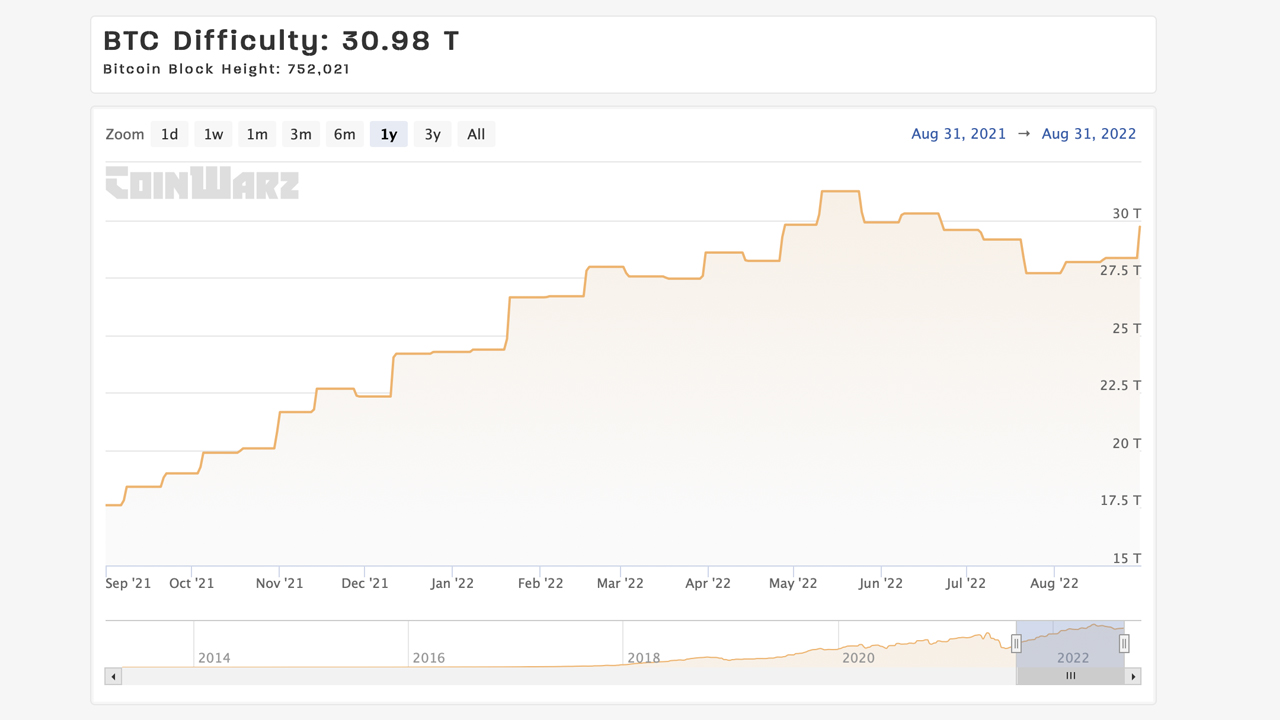On Wednesday, Bitcoin’s mining difficulty jumped 9.26% higher, registering the second highest difficulty increase of 2022. The latest increase is Bitcoin’s third difficulty increase since August 4, 2022, and it is now 11.63% harder to find bitcoin block rewards.
Bitcoin Difficulty Jumps 9.26% — Metric Prints Second Biggest Increase This Year
Bitcoin (BTC) has experienced its third difficulty increase this month as its difficulty increased by 9.26% on August 31st. The difficulty change took place at block height 751,968, and the 9.26% jump is the second largest this year. The largest increase in 2022 took place 223 days ago on January 20, 2022, at block height 719,712.

Currently, the difficulty is 30.98 trillion, which is only 0.27 below the network difficulty’s all-time high (ATH) of 31.25 trillion on May 10, 2022. With bitcoin’s lower USD value and a difficulty of 9.26%, miners suffered a blow. . In fact, the last three difficulty levels have made it 11.63% harder to find a bitcoin block reward before August 4th.
On August 4, at block height 747,936, Bitcoin’s mining difficulty increased by 1.74% and two weeks later it increased again by 0.63%. Five days ago, Bitcoin.com News reported on society discussing the possibility that the difficulty may see a noticeable increase. August 25, Blocksbridge Consulting tweeted that it awaited “a remarkable jump in difficulty”.
Furthermore, during the same week, Bitcoin’s hashrate increased to 282.21 exahash per second (EH/s). The hash rate was about 3.35% lower than the all-time high (ATH) recorded on June 8, 2022, at block height 739,928. At the time of writing, Bitcoin’s hash rate is flying along at 236.33 EH/s.
The difficulty is increasing and the lower BTC value has not affected miners yet as the hash rate continues to run at high speeds. The difficulty increases when 2016 bitcoin block rewards are detected “too fast,” and the calculation decreases when the block time or interval is “too slow.”
The average block interval and current hashrate speed show that another increase is likely in the cards
Satoshi Nakamoto’s design means that approximately every ten minutes a new BTC block is found as the DAA system is modeled by a Poisson distribution scheme. The average block interval at the time of writing is 7:59 minutes, which means that if the next 2016 bitcoin block rewards are discovered “too soon”, the next difficulty is estimated to increase again.

There are approximately 1,964 BTC block rewards left until the next difficulty shift, which is estimated to take place on September 12, 2022. If the increase is higher on that day, there is a strong possibility that the network difficulty may well surpass the ATH recorded 113 days since the 10 .May 2022.
Tags in this story
Bitcoin, Bitcoin (BTC), Bitcoins hashrate, block intervals, block rewards, BTC Hashrate, difficulty, difficulty change, difficulty, Global Hashrate, Hashrate, May 10, 2022, calculations, Miners, mining, mining bitcoin, Mining BTC, Overall Hashrate, PoW, proof of work
What do you think of the latest difficulty change? Let us know what you think about this topic in the comments section below.
Jamie Redman
Jamie Redman is the news editor at Bitcoin.com News and a financial technology journalist living in Florida. Redman has been an active member of the cryptocurrency community since 2011. He has a passion for Bitcoin, open source and decentralized applications. Since September 2015, Redman has written more than 5,700 articles for Bitcoin.com News about the disruptive protocols emerging today.
Image credit: Shutterstock, Pixabay, Wiki Commons





